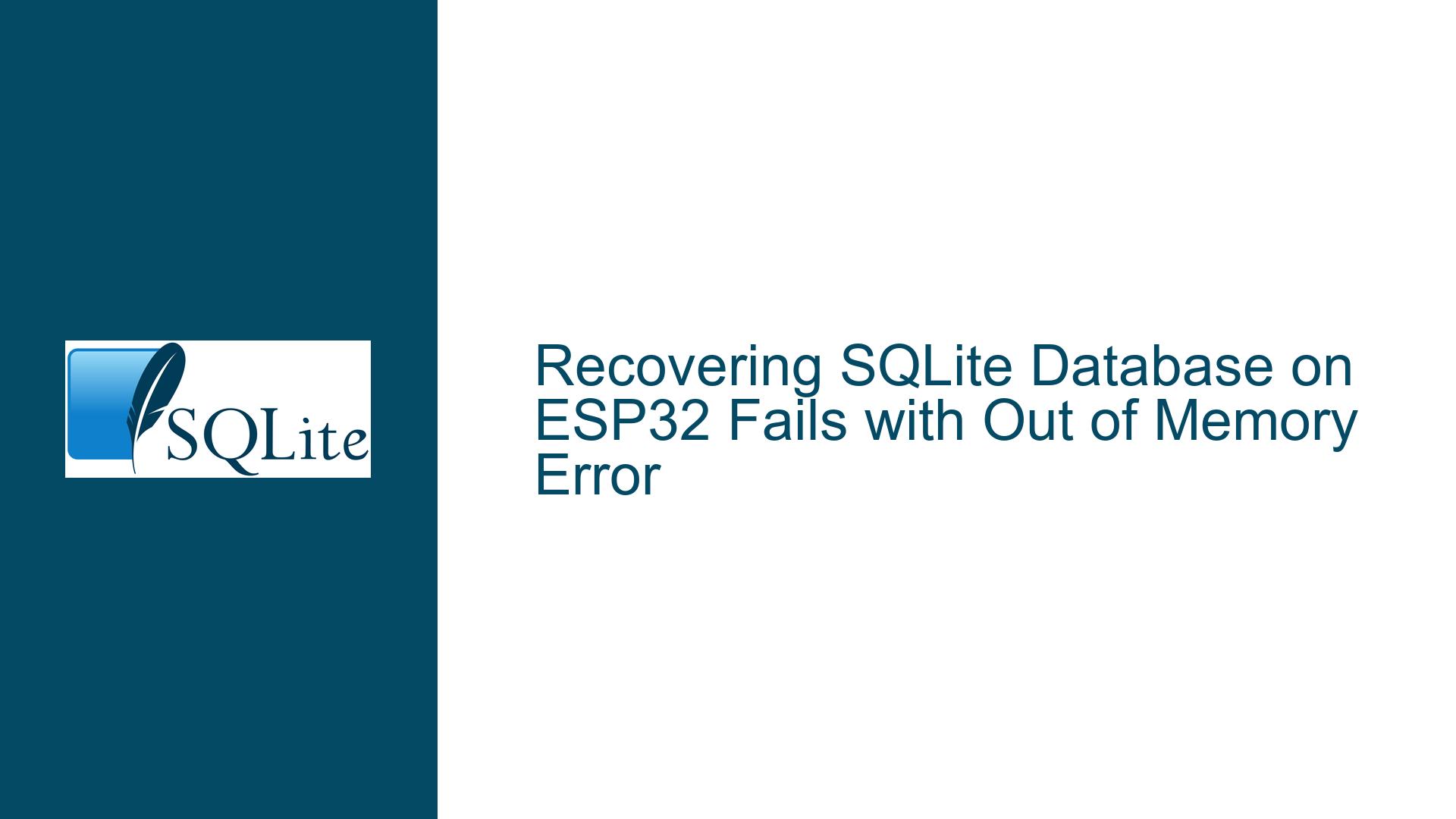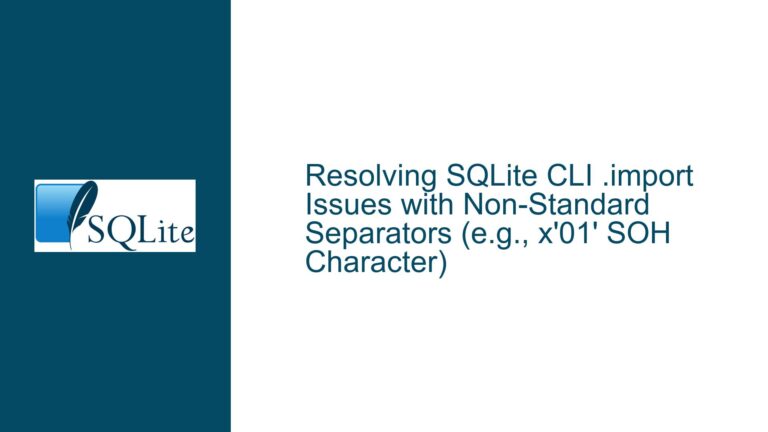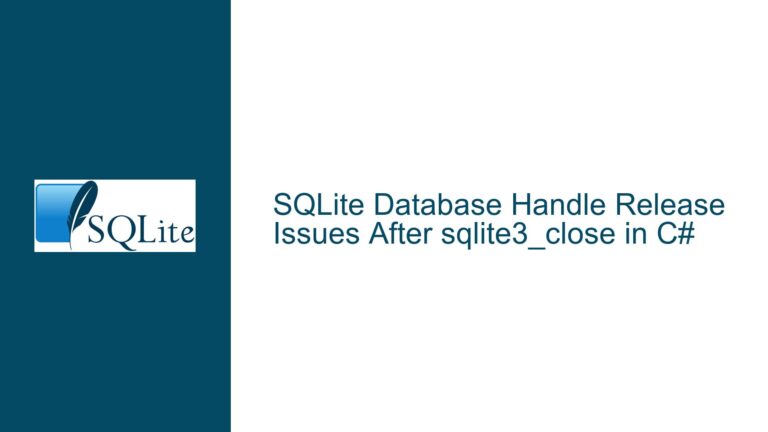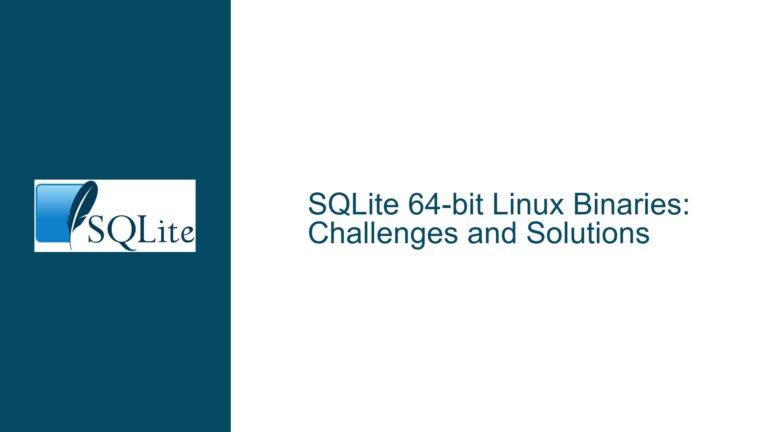Recovering SQLite Database on ESP32 Fails with Out of Memory Error
Issue Overview: Memory Constraints and Recovery Process Failures in SQLite on ESP32
The core issue revolves around attempting to recover or maintain a SQLite database on an ESP32 microcontroller with 512KB of RAM. The user encounters "out of memory" errors when invoking recovery procedures via the sqlite3recover API or executing operations such as VACUUM. The problem persists even when working with a minimal test database (e.g., a single table with one row and two columns). This suggests that the error is not due to database corruption or size but rather stems from hardware limitations, SQLite configuration mismatches, or API usage nuances specific to resource-constrained environments. Key observations include:
- Recovery Workflow Failures: The
sqlite3recoverAPI fails duringrecovery_step()when executing a basic query againstsqlite_schema, returningSQLITE_NOMEM(out of memory). This occurs despite attempts to adjust cache size (SQLITE_DEFAULT_CACHE_SIZE) and allocate static memory buffers viaSQLITE_CONFIG_HEAP. - VACUUM Command Failures: The
VACUUM main INTOoperation also fails with an out-of-memory error, traced to memory allocation failures during subjournal writes. The system attempts to allocate ~64KB (65540 bytes) for journaling, which exceeds available memory under concurrent usage. - Hardware Constraints: The ESP32’s 512KB RAM imposes strict limits on SQLite’s memory-intensive operations. While SQLite is designed for embedded systems, recovery and maintenance tasks often require transient memory allocations that exceed typical runtime usage.
This issue highlights the challenges of deploying SQLite in environments with extreme memory constraints, particularly when leveraging advanced features like recovery APIs or schema maintenance commands. The problem is exacerbated by SQLite’s default configuration settings, which are optimized for general-purpose systems rather than microcontrollers.
Possible Causes: Memory Allocation Patterns and Configuration Mismatches
1. Insufficient Heap Space for SQLite Operations
- Journaling Overhead: SQLite uses write-ahead logging (WAL) or rollback journals to ensure atomicity and durability. Operations like
VACUUMand recovery require temporary storage for journal pages. The default journal spill threshold (SQLITE_STMTJRNL_SPILL) is 64KB, which may exhaust available heap space on the ESP32. - Recovery API Memory Demands: The
sqlite3recoverAPI reconstructs the database by scanning pages and rebuilding schemas. This process involves caching schema metadata, iterating through tables, and generating intermediate SQL statements, all of which consume heap memory.
2. Misconfigured SQLite Memory Limits
- Default Cache Size: The
SQLITE_DEFAULT_CACHE_SIZEdetermines the number of pages cached in memory. Increasing this value without corresponding heap adjustments can worsen memory pressure. - Static Heap Allocation: Using
SQLITE_CONFIG_HEAPwith a fixed buffer may fail if the buffer size is insufficient for transient allocations during recovery orVACUUM.
3. ESP32-Specific Memory Fragmentation
- Heap Fragmentation: Repeated allocations and deallocations during recovery can fragment the ESP32’s heap, preventing large contiguous blocks from being allocated even if total free memory appears adequate.
- Concurrent Memory Usage: Background tasks (Wi-Fi stacks, RTOS threads) may consume portions of the heap, leaving insufficient space for SQLite operations.
4. API Usage and Error Handling
- Unoptimized Recovery Workflow: The recovery process may attempt to load the entire schema or row data into memory, which is infeasible on the ESP32. The
.recoverCLI command optimizes memory usage by streaming data incrementally, whereas a custom API implementation might not. - Missing Soft Heap Limits: The
sqlite3_soft_heap_limit64()function is not invoked, allowing SQLite to request memory beyond the ESP32’s capacity.
Troubleshooting Steps, Solutions & Fixes: Optimizing SQLite for Low-Memory Environments
Step 1: Diagnose Memory Usage During Critical Operations
- Enable SQLite Memory Statistics:
sqlite3_config(SQLITE_CONFIG_MEMSTATUS, 1);This enables tracking of memory usage, accessible via
sqlite3_memory_used(). - Log Heap State:
Use ESP32-specific APIs (e.g.,heap_caps_get_free_size()) to monitor free memory before and during recovery/VACUUM operations.
Step 2: Adjust SQLite Configuration for Low-Memory Operation
- Reduce Page Cache Size:
sqlite3_config(SQLITE_CONFIG_PAGECACHE, pBuf, sz, N);Allocate a small static buffer for page caching (e.g., 10 pages of 1KB each).
- Lower Statement Journal Spill Threshold:
Compile with-DSQLITE_STMTJRNL_SPILL=1024or set at runtime:sqlite3_config(SQLITE_CONFIG_STMTJRNL_SPILL, 1024);This reduces the journal buffer size from 64KB to 1KB, preventing oversized allocations.
Step 3: Optimize Recovery API Usage
- Stream Data Incrementally:
Avoid loading the entire schema or row data into memory. Usesqlite3_recover_step()iteratively and free resources after each step. - Disable Unnecessary Features:
Configure the recovery handle to skip indexes, triggers, or other schema elements that are non-essential:sqlite3_recover_config(pRecover, SQLITE_RECOVER_INDEXES, 0);
Step 4: Implement Memory Safeguards
- Set a Soft Heap Limit:
sqlite3_soft_heap_limit64(256 * 1024); // 256KBForces SQLite to return
SQLITE_NOMEMbefore exhausting system memory. - Use Memory Pools:
Allocate dedicated memory pools for SQLite using ESP32’sheap_caps_malloc()withMALLOC_CAP_SPIRAM(if external RAM is available).
Step 5: Alternative Recovery Strategies
- Offload Recovery to a Host System:
Transfer the database to a PC, recover it using the SQLite CLI’s.recover, and write it back to the ESP32. - Use a Minimal Backup System:
Implement incremental backups to external storage (SD card) instead of relying on in-place recovery.
Step 6: Debugging ESP32-Specific Memory Issues
- Analyze Heap Allocation Failures:
Replacesqlite3_malloc()with a wrapper that logs allocation sizes and addresses:void *sqlite3_malloc_debug(int size) { void *p = malloc(size); ESP_LOGI("SQLITE_MEM", "Alloc %d bytes @ %p", size, p); return p; } - Enable SQLite Debugging:
Compile SQLite with-DSQLITE_DEBUGto trace memory usage and API calls.
Step 7: Long-Term Mitigations
- Database Design Optimization:
UsePRAGMA page_size=512to reduce per-page memory overhead. - Avoid VACUUM on ESP32:
ScheduleVACUUMoperations during maintenance windows with guaranteed free memory, or avoid them entirely by usingauto_vacuum=INCREMENTAL. - Leverage ESP32’s PSRAM:
If available, configure SQLite to use external PSRAM for large allocations via custom memory hooks.
By systematically addressing memory configuration, API usage, and hardware constraints, developers can mitigate out-of-memory errors when recovering or maintaining SQLite databases on ESP32. The key is to align SQLite’s memory demands with the microcontroller’s capabilities through targeted optimizations and alternative workflows.






